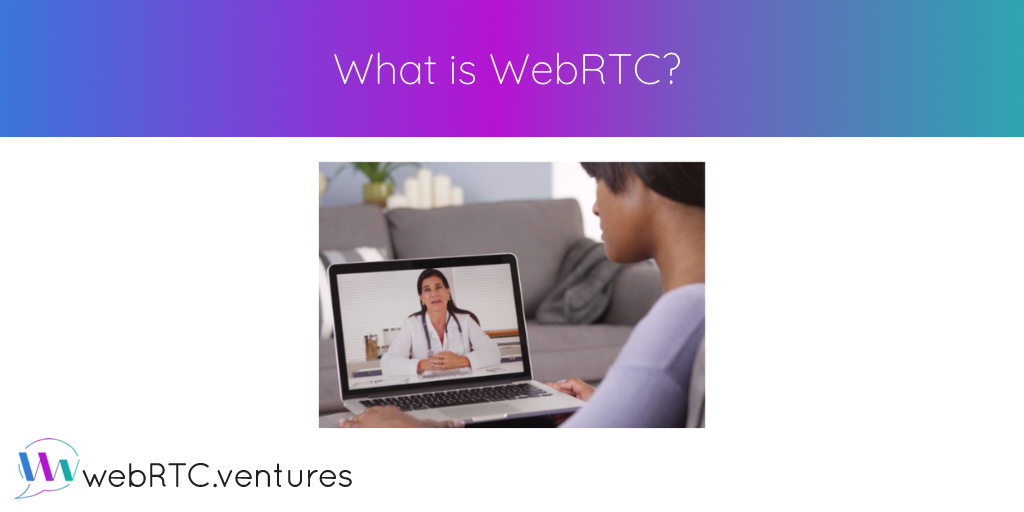Let’s talk about the very basics of what WebRTC is and when and why we might use it.
WebRTC:
- Is an HTLM5 standard
- Uses Javascript
- Allows you to control the camera and microphone in the browser with no downloads
- Is encrypted and secure
In other words, WebRTC allows you to set up a live peer-to-peer connection between two different browsers – or more – to exchange private video, audio, and data between them. WebRTC is a form of Real-Time Communication (RTC).
If you are a visual learner, watch our WebRTC Tips by WebRTC.ventures video, “What is WebRTC?” below. Or, read on.
WebRTC Use Cases
You can use WebRTC in a lot of different ways, and some of them are simpler than you might imagine. WebRTC can be used to grab access to a camera and take a profile picture. Or, you could use it to access a person’s microphone to record audio. All of this, of course, needs to be done with the user’s permission. They will receive a browser alert that you are asking for permission to use their camera or microphone and they can allow or disallow that action based on their privacy concerns.
More commonly, WebRTC connects browsers to exchange information. To do this, you need a signaling server to allow some handshaking to establish that connection. Once the browsers are connected, you can have live, encrypted peer-to-peer exchange of video, audio, and a data channel for a variety of use cases.
What kinds of industries and applications use WebRTC?
There are a lot of different applications that use WebRTC, or that could be enhanced if they did! Our company, WebRTC.ventures, is a custom development shop that specializes in building live video applications using WebRTC. We’ve built real-time communication applications for a wide range of industries and use cases including:
- Video conferencing
- Contact centers
- Telemedicine
- Insurance
- In-context communications
- Dating/social media
- Gaming
- Internet of Things/P2P Data Transfer
Certainly, the most common thing WebRTC is used for is video conferencing–as the basis of video chat applications. If you are using a meeting tool through your browser (meaning you do not download an app), you are using WebRTC.
You can build WebRTC into call centers to allow live video calls or enable sign language interpretation. WebRTC is also ideal when some aspect of the customer support would be better conducted over video so the agent can actually see what the customer is seeing.
Telehealth and telemedicine is a big area for WebRTC because it has encryption built right into it. This is ideal for HIPAA compliance and general privacy and security concerns around healthcare.
For insurance companies, WebRTC can greatly aid the claims process. For example, a customer who has just been rear ended can simply turn the camera on their car and show you the damage.
In-context communications means communicating with your customer while knowing the context of where they are in your application. Imagine that I am in my online banking application and I contact customer support. Because I’m logged in, the customer service rep already knows who I am and where I am on their website when the chat starts. I don’t need to identify myself or explain how far I have gotten in accomplishing the task at hand. WebRTC can enable this over video, or audio, or through the data channel for text chat.
Social media applications are increasingly incorporating video chat and typically using WebRTC to do it. You can easily imagine dating applications using this technology. Being able to meet prospective dates remotely and securely over WebRTC can be an important part of that experience, especially during pandemic times.
You can also build live video into gaming applications and use that same real-time channel for the exchange of data during a game.
The WebRTC data channel can, in fact, be used for any peer-to-peer data transfer. For example, we have used it in Internet of Things (IoT) applications to put a camera on a remote device in the field so a remote operator can see what the device is doing. This is a great application of WebRTC. You can also use the connection between the operator and the IoT device to send commands to exchange and receive data.
The sky is the limit
As you can see, there are all sorts of applications for which WebRTC can be used and these are just a few. The sky is truly the limit.
Our team at WebRTC.ventures combines our expertise in real-time development and user experience (UX) design with the best practices in WebRTC to create beautiful, user-friendly web and mobile applications in many different industries. You can read some of our company’s client successes on our website (or at least those that we are allowed to share!) You can also find more tips like these on our YouTube Channel, and follow us on Twitter @webrtcventures.
And, of course, if you want to build a WebRTC application of your own, contact us today!




